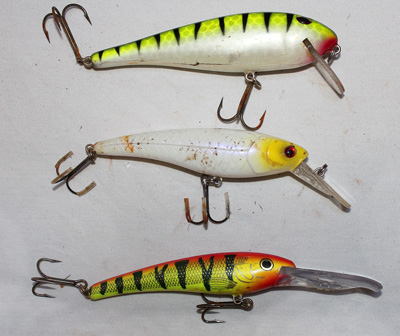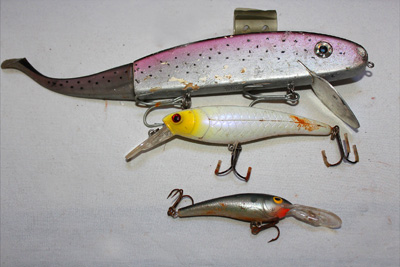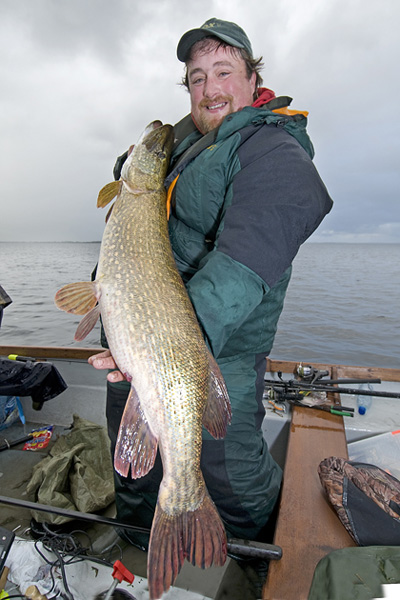Of all the lures that we use crankbaits will probably be the most familiar to UK anglers and most UK anglers of a certain age will almost certainly have first come to know these lures by their old name of ‘plugs’, crankbaits being an imported term from the States.
Whatever you choose to call them there is an underlying principle to all of them, that being that the action of the lure is predominantly imparted through the retrieval of the lure by winding or ‘cranking’. Most can also have extra action imparted by the angler twitching or jerking the rod, but in reality they will catch just as many fish on a straight retrieve.
We can further divide crankbaits down into two categories, floating and sinking. Most popular tend to be floating divers. These lures when cast in will float and only dive below the surface when retrieved and then usually to a set depth, typically from 1-15 feet.
 The depth that the lures dive to is dependent upon three factors, these being: the speed of retrieval and the size and the angle of the diving vane. As a guide the larger the vane and the smaller the angle the deeper the lure will dive. Lures with a diving vane that points almost straight down, or of over 45 degrees to the body will tend to work in the upper layers down to around four or five feet. Thanks to this we can control the depth that the lure runs and thereby match the depth that the lure fishes to waters of a similar depth, or where we want a lure to run at a set depth.
The depth that the lures dive to is dependent upon three factors, these being: the speed of retrieval and the size and the angle of the diving vane. As a guide the larger the vane and the smaller the angle the deeper the lure will dive. Lures with a diving vane that points almost straight down, or of over 45 degrees to the body will tend to work in the upper layers down to around four or five feet. Thanks to this we can control the depth that the lure runs and thereby match the depth that the lure fishes to waters of a similar depth, or where we want a lure to run at a set depth.
There are times though when we can get lures to dive slightly deeper than their usual running depth, the two main ones being when trolling and when fishing fast moving water. Trolling lures often can get a few extra feet out of any lure but as I have covered this in another FishingMagic article that will appear shortly I will leave the complex subject of trolling to another day.
What may be more relevant though is using lures in flowing water, after all many of us target predators in such waters. On such waters whether you fish with, or against, the flow will alter your lure’s passage. If you fish with the flow you will have to retrieve faster than the current speed otherwise the speed of flow will counteract the action of the lure. The flowing water will also tend to push the lure up in the water, so it won’t dive as deeply. The converse is true if we fish against the current as here the current will act upon the lure, meaning that lures can be fished very slowly as just the current passing over them will draw some action from them, whereas a full retrieve will really get the lure to dive down. However, there will always be some degree of the lure coming in closer to the bank as we retrieve, as the water pressure upon the loop of line in the flow eases the lure back towards the bank. Therefore positioning oneself to cover certain spots may require a certain amount of trial and error.
 As far as the tackle required for crankbait fishing is concerned, unless you are going to be throwing really big crankbaits (and crankbaits can be over a foot long) then a normal ‘spinning’ rod of between 7 and 10 feet long will be fine. The length that you choose will depend greatly upon where you fish and your own height. As we retrieve lures with the rod pointing down towards the water if you are of a tall build and use a short rod there will be a tendency to stoop over slightly. Whilst this may be okay in the short term it will get uncomfortable and, as someone that suffers greatly with back problems, I would advise getting a longer rod and taking this out of the equation.
As far as the tackle required for crankbait fishing is concerned, unless you are going to be throwing really big crankbaits (and crankbaits can be over a foot long) then a normal ‘spinning’ rod of between 7 and 10 feet long will be fine. The length that you choose will depend greatly upon where you fish and your own height. As we retrieve lures with the rod pointing down towards the water if you are of a tall build and use a short rod there will be a tendency to stoop over slightly. Whilst this may be okay in the short term it will get uncomfortable and, as someone that suffers greatly with back problems, I would advise getting a longer rod and taking this out of the equation.
Reels need not be anything too expensive either. Choice will come down to a multiplier or a fixed spool reel and whilst I am firmly of the belief that learning to use a multiplier will only be an advantage in the long term they are not strictly necessary with this type of set up, although it happens to be about the best set up to learn with as a spinning rod is a lot more forgiving, and has an action that will help the angler to cast, much more than a jerkbait set up where a multiplier reel is a must have.
If though you have no intention in moving on up to jerkbaiting in the future then a medium sized fixed spool reel that will hold about 150 yards of 50lb breaking strain braid will be perfectly fine. You may at this point think that 50lb braid is a bit of overkill, but with braid of this breaking strain you should get most lures back should you snag up as 50lb braid will straighten most lure hooks.
So what then of the lures themselves?
 There are a myriad of different crankbaits and as any keen lure angler will testify you will very quickly build up a collection of lures as just the process of lure collecting in itself can become almost a secondary hobby to using them! However, as most lure anglers will also agree you will probably regularly use less than half of the lures that you have collected at great expense!
There are a myriad of different crankbaits and as any keen lure angler will testify you will very quickly build up a collection of lures as just the process of lure collecting in itself can become almost a secondary hobby to using them! However, as most lure anglers will also agree you will probably regularly use less than half of the lures that you have collected at great expense!
I could go into chapter and verse about what lures to buy and which to leave at home, but the truth is that any two lure anglers will have vastly different opinions about the same lure. I know many lure anglers that wouldn’t have, for instance, a Rapala Super Shad Rap anywhere near their lure bag, yet I have caught many fish on them, particularly when trolled.
The best advice that I can offer on lure types is to try and match the type of lure to that which you want to catch, where you are most likely to lure fish and that which matches your tackle the best. For example, if your prime targets are likely to be chub and perch, then eight inch long lures are not really going to be the best bet and vice versa. Furthermore if zander and perch are likely to feature strongly in your catches then it’s pretty pointless having a lot of shallow-running lures as these species favour the bottom layers of the water.
Whatever you decide upon crankbaits are a fantastic, fun way to get into lure fishing, but in the next article I will talk about the method of lure fishing that has probably done more than any to bring people into the sport than any other and is without doubt my absolute favourite: jig fishing.











